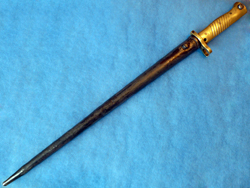The restoration of a zinc ersatz scabbard
In this example, this rare ersatz bayonet EB 126 was in a slightly twisted zinc scabbard in the half lengthwise.
There was a very unsightly huge welding burr near the round ferrule.
Despite this, I did not hesitate to acquire this bayonet which was in good condition.
I had the choice between leaving the scabbard in this original condition or being repaired for decades, or between, eliminating the burr that was hard to accept.
After careful considerations, I chose the second option, knowing that during the work, the fragility of zinc may be the cause of irreversible damages.
To fix this ersatz bayonet scabbard, I proceeded in two stages : removal of the blur and then straightening. I started to lift the burr with a lever to remove as little material as possible.
We can see on these 2 pictures left and right that the blur is very important on one side : (click on the photos for details) ; the ball of zinc has been left by the armourer.
Before using the screwdriver as a lever, I split the ball in two parts with a steel disc grinder.
I position the screwdriver in a flat position and I slowly progress towards the junction, turning slightly to the right and to the left along the side of the scabbard.
Be careful not to touch the scabbard body with the edges of the screwdriver to avoid making some tool marks.
The first half of the bowl folds and allows the screwdriver to pass under the second half bowl attached to the edge of the cap.
On voit bien sur ces 2
photos à gauche et à droite
que la rouille est très superficielle. le fourreau parait bien bleu
sans trop de rouille
superficielle.
Je vais donc plus
m'attarder sur la baïonnette qui est plus facile à travailler; on
risque moins de faire des dégâts sur l'acier que le fourreau qui a su
garder son bleu à 80%, et pour le nettoyer, j'utiliserai seulement de
l'huile avec de la laine d'acier 000.
On voit bien sur ces 2
photos à gauche et à droite
que la rouille est très superficielle. le fourreau parait bien bleu
sans trop de rouille
superficielle.
Je vais donc plus
m'attarder sur la baïonnette qui est plus facile à travailler; on
risque moins de faire des dégâts sur l'acier que le fourreau qui a su
garder son bleu à 80%, et pour le nettoyer, j'utiliserai seulement de
l'huile avec de la laine d'acier 000.
On voit bien sur ces 2
photos à gauche et à droite
que la rouille est très superficielle. le fourreau parait bien bleu
sans trop de rouille
superficielle.
Je vais donc plus
m'attarder sur la baïonnette qui est plus facile à travailler; on
risque moins de faire des dégâts sur l'acier que le fourreau qui a su
garder son bleu à 80%, et pour le nettoyer, j'utiliserai seulement de
l'huile avec de la laine d'acier 000.
On voit bien sur ces 2
photos à gauche et à droite
que la rouille est très superficielle. le fourreau parait bien bleu
sans trop de rouille
superficielle.
Je vais donc plus
m'attarder sur la baïonnette qui est plus facile à travailler; on
risque moins de faire des dégâts sur l'acier que le fourreau qui a su
garder son bleu à 80%, et pour le nettoyer, j'utiliserai seulement de
l'huile avec de la laine d'acier 000.



































